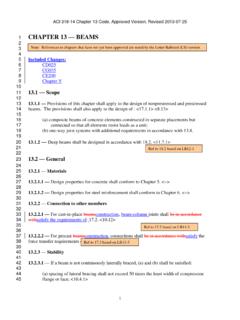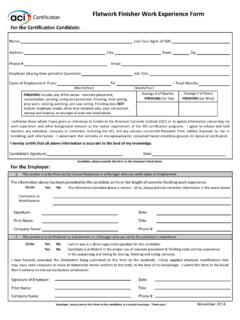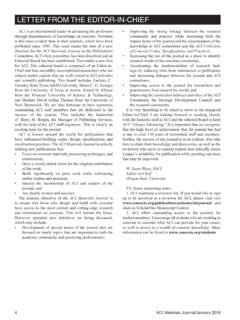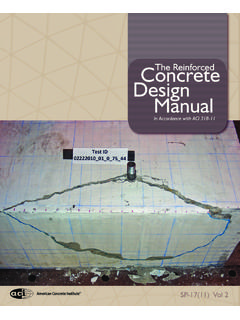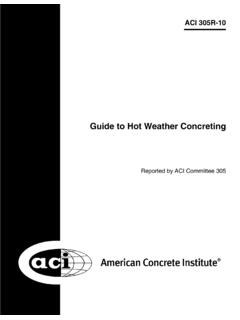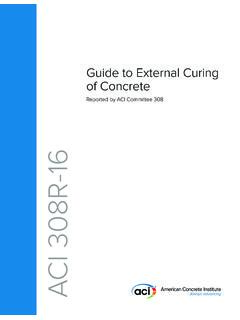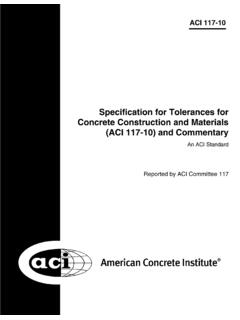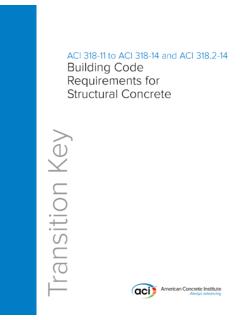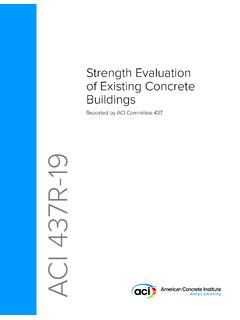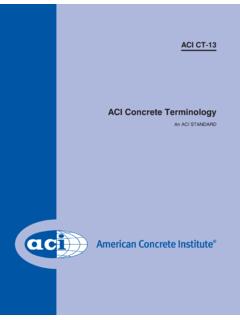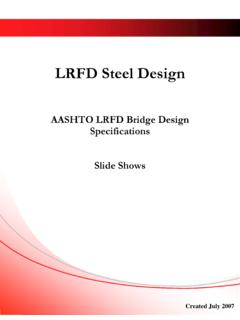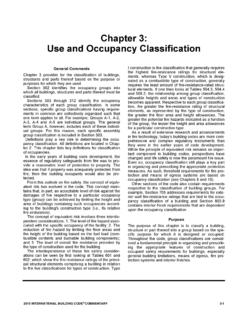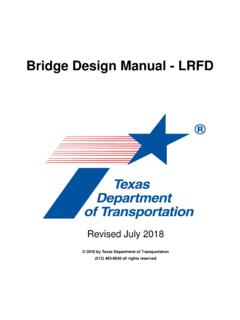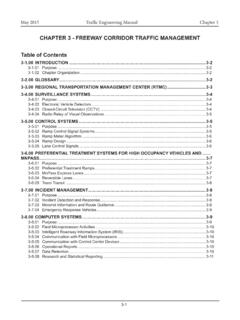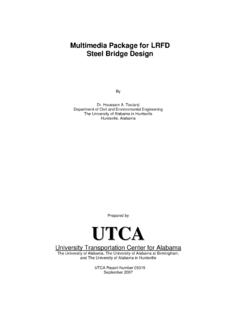Transcription of ACI 318-14 - American Concrete Institute
1 Draft Table of Contents Building Code Requirements for Structural Concrete and CommentaryACI 318-14 BUILDING CODE REQUIREMENTS FOR STRUCTURAL Concrete ( aci 318 14 ) chapter 1 General Scope of ACI 318 This chapter addresses (a) through (h): (a) General requirements of this Code (b) Purpose of this Code (c) Applicability of this Code (d) Interpretation of this Code (e) Definition and role of the building official and the licensed de sign professional (f) Construction documents (g) Testing and inspection (h) Approval of special systems of design, construction, or alternative construction materials. General Purpose Applicability Interpretation Building official Licensed design professional Construction documents and design records Testing and inspection Approval of special systems of design, construction, or alternative construction materials chapter 2 Notation and Terminology Scope This chapter defines notation and terminology used in this Code.
2 Notation Terminology chapter 3 Referenced Standards Scope Standards, or specific sections thereof, cited in this Code, including Annex, Appendices, or Supplements where prescribed, are referenced without exception in this Code, unless specifically noted. Cited standards are listed in the following with their serial designations, including year of adoption or revision. Referenced standards American Association of State Highway and Transportation Officials (AASHTO) American Concrete Institute (ACI) American Society of Civil Engineers (ASCE)/Structural Engineering Institute (SEI) ASTM International American Welding Society (AWS) chapter 4 Performance Requirements for Structural Members and Structural Systems Scope This chapter shall apply to design of structural Concrete in structures or portions of structures defined in chapter 1.
3 Materials Design loads Structural systems and load paths Seismic force resisting system Diaphragms and collectors Structural analysis Strength Serviceability Durability Sustainability Structural integrity General Minimum requirements for structural integrity Fire resistance Requirements for specific types of construction Precast Concrete systems Prestressed Concrete systems Composite Concrete flexural members Structural plain Concrete systems Construction and inspection Strength evaluation of existing structure chapter 5 Loads Scope This chapter shall apply to selection of load factors and combinations used in design, except as permitted in chapter 27.
4 General load factors and combinations chapter 6 Structural Analysis Scope This chapter shall apply to methods of analysis, modeling of members and structural systems, and calculation of load effects. General Modeling assumptions General T beam geometry Arrangement of live load Simplified method of analysis for nonprestressed continuous beams and one way slabs First order analysis General Modeling of members and structural systems Section properties Factored load analysis Service load analysis Slenderness effects, moment magnification method Stability properties Moment magnification method: Nonsway frames Moment magnification method: Sway frames Redistribution of moments in continuous flexural members Elastic second order analysis General Section properties Inelastic second order analysis General Acceptability of finite element analysis chapter 7 One Way Slabs Scope This chapter shall apply to the design of nonprestressed and prestressed slabs reinforced for flexure in one direction, including: (a) Solid slabs (b) Slabs cast on stay in place, noncomposite steel deck (c) Composite slabs of Concrete elements constructed in separate placements but connected so that all elements resist loads as a unit (d) Precast, prestressed hollow core slabs.
5 General Materials Connection to other members Design Limits Minimum slab thickness Calculated deflection limits Reinforcement strain limit in nonprestressed slabs Stress limits in prestressed slabs Required strength General Factored moment Factored shear Design strength General Moment Shear Reinforcement limits Minimum flexural reinforcement in nonprestressed slabs Minimum flexural reinforcement in in prestressed slabs Minimum shear reinforcement Minimum shrinkage and temperature reinforcement Reinforcement detailing General Reinforcement spacing Flexural reinforcement in nonprestressed slabs Termination of reinforcement Flexural reinforcement in prestressed slabs Termination of prestressed reinforcement Termination of deformed reinforcement in slabs with unbonded tendons Shear reinforcement Shrinkage and temperature reinforcement Nonprestressed reinforcement Prestressed reinforcement chapter 8 Two Way Slabs Scope This chapter shall apply to the design of nonprestressed and prestressed slabs reinforced for flexure in two directions, with or without beams between supports, including (a) through (d).
6 (a) Solid slabs (b) Slabs cast on stay in place, noncomposite steel deck (c) Composite slabs of Concrete elements constructed in separate placements but connected so that all elements resist loads as a unit (d) Two way joist systems in accordance with General Materials Connections to other members Design limits Minimum slab thickness Calculated deflection limits Reinforcement strain limit in nonprestressed slabs Stress limits in prestressed slabs Required strength General Factored moment Factored slab moment resisted by the column Unbalanced factored moment Factored one way shear Factored two way shear Critical section Factored two way shear stress due to shear and factored slab moment resisted by the column Design strength General Moment Shear Openings in slab systems Reinforcement limits Minimum flexural reinforcement in nonprestressed
7 Slabs Minimum flexural reinforcement in prestressed slabs Reinforcement detailing General Flexural reinforcement spacing Corner restraint in slabs Flexural reinforcement in nonprestressed slabs Termination of reinforcement Structural integrity Flexural reinforcement in prestressed slabs Termination of prestressed reinforcement Termination of deformed reinforcement in slabs with unbonded tendons Structural integrity Stirrups Headed shear stud reinforcement Nonprestressed two way joist systems General Joist systems with structural fillers Joist systems with other fillers Lift slab construction Direct design method General Limitation for use of direct design method Total factored static moment for a span Distribution of total factored static moment Factored moments in column strips Factored moments in middle strips Factored moments in columns and walls Factored shear in slab systems with beams Equivalent frame method General Equivalent frames Slab beams Columns Torsional members Factored moments chapter 9 Beams Scope This chapter shall apply to the design of nonprestressed and prestressed beams, including.
8 (a) Composite beams of Concrete elements constructed in separate placements but connected so that all elements resist loads as a unit (b) One way joist systems in accordance with (c) Deep beams in accordance with General Materials Connection to other members Stability T Beam construction Design limits Minimum beam depth Calculated deflection limits Reinforcement strain limit in nonprestressed beams Stress limits in prestressed beams Required strength General Factored moment Factored shear Factored torsion Design strength General Moment Shear Torsion Reinforcement levels Minimum flexural reinforcement in nonprestressed beams Minimum flexural reinforcement in prestressed beams Minimum shear reinforcement Minimum torsion reinforcement Reinforcement detailing General Reinforcement spacing Flexural
9 Reinforcement in nonprestressed beams Termination of reinforcement Flexural reinforcement in prestressed beams Termination of prestressed reinforcement Termination of deformed reinforcement in slabs with unbonded tendons Longitudinal torsion reinforcement Transverse reinforcement General Shear Torsion Lateral support of compression reinforcement Structural integrity reinforcement in cast in place beams Nonprestressed one way joist systems General Joist systems with structural fillers Joist systems with other fillers Deep beams General Dimensional limits Reinforcement limits Reinforcement detailing chapter 10 Columns Scope This chapter shall apply to the design of nonprestressed, prestressed, and composite columns, including reinforced Concrete pedestals.
10 General Materials Composite columns Connection to other members Design limits Dimensional limits Required strength General Factored axial force and moment Design strength General Axial force and moment Shear Torsion Reinforcement Limits Minimum and maximum longitudinal reinforcement Minimum shear reinforcement Reinforcement: detailing General Reinforcement spacing Longitudinal reinforcement Offset bent longitudinal reinforcement Splices of longitudinal reinforcement Lap splices End bearing splices Transverse reinforcement General Lateral support of longitudinal bars using ties or hoops Lateral support of longitudinal bars using spirals Lateral support of offset bent longitudinal bars Shear chapter 11 Walls Scope This chapter shall apply to the design of nonprestressed and prestressed walls including (a) through (c): (a) Cast in place (b) Precast in plant (c) Precast on site including tilt up.
